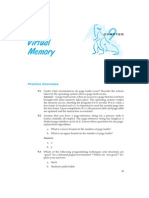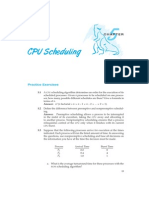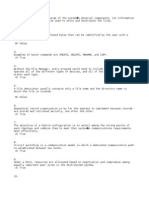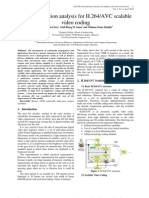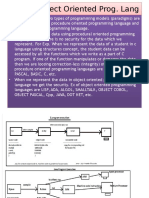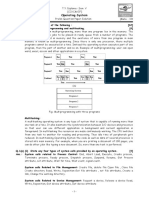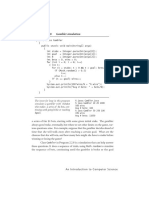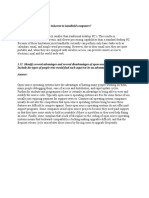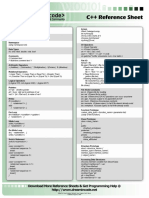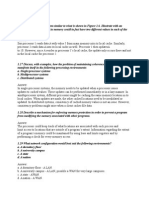100%(2)100% found this document useful (2 votes)
655 viewsOS Concepts Chapter 2 Solution To Practice Exercises Part 2
System programs provide basic functionality to users so they do not need to write their own programs to solve common problems. The layered approach to system design makes the operating system easier to debug and modify by limiting the impact of changes. Some key services provided by an operating system include program execution, I/O operations, file system manipulation, communications, and error detection. User programs cannot reliably provide these services due to issues around resource allocation, device access control, and handling process-independent errors.
Uploaded by
Alfred FredCopyright
© © All Rights Reserved
Available Formats
Download as DOCX, PDF, TXT or read online on Scribd
100%(2)100% found this document useful (2 votes)
655 viewsOS Concepts Chapter 2 Solution To Practice Exercises Part 2
System programs provide basic functionality to users so they do not need to write their own programs to solve common problems. The layered approach to system design makes the operating system easier to debug and modify by limiting the impact of changes. Some key services provided by an operating system include program execution, I/O operations, file system manipulation, communications, and error detection. User programs cannot reliably provide these services due to issues around resource allocation, device access control, and handling process-independent errors.
Uploaded by
Alfred FredCopyright
© © All Rights Reserved
Available Formats
Download as DOCX, PDF, TXT or read online on Scribd
You are on page 1/ 2
Practice Exercises
2.7 What is the purpose of system programs?
Answer:
System programs can be thought of as bundles of useful system calls. They provide basic
functionality to users so that users do not need to write their own programs to solve
common problems.
2.8 What is the main advantage of the layered approach to system design?
What are the disadvantages of using the layered approach?
Answer:
As in all cases of modular design, designing an operating system in a modular way has
several advantages. The system is easier to debug and modify because changes affect
only limited sections of the system rather than touching all sections of the operating
system.Information is kept only where it is needed and is accessible only within
a defined and restricted area, so any bugs affecting that data must be limited to a specific
module or layer.
2.9 List five services provided by an operating system. Explain how each provides
convenience to the users. Explain also in which cases it would be impossible for userlevel programs to provide these services.
Answer:
a.Program execution.
The operating system loads the contents (or sections) of a file into memory and begins its
execution. A user-level program could not be trusted to properly allocate CPU time.
b.I/O operations.
Disks, tapes, serial lines, and other devices must be communicated with at a very low
level. The user need only specify the device and the operation to perform on it, while the
system converts that request into device- or controller-specific commands. User-level
programs cannot be trusted to access only devices they should have access to and to
access them only when they are otherwise unused.
c.File-system manipulation.
There are many details in file creation,deletion, allocation, and naming that users should
not have to perform. Blocks of disk space are used by files and must be tracked.
Deleting a file requires removing the name file information and freeing the allocated
blocks. Protections must also be checked to assure proper file access. User programs
could neither ensure adherence to protection methods nor be trusted to allocate only free
blocks and deallocate blocks on file deletion.
d.Communications.
Message passing between systems requires messages to be turned into packets of
information, sent to the network controller, transmitted across a communications
medium,and reassembled by the destination system. Packet ordering and data correction
must take place. Again, user programs might not coordinate access to the network device,
or they might receive packets destined for other processes.
e.Error detection.
Error detection occurs at both the hardware and software levels. At the hardware level, all
data transfers must be inspected to ensure that data have not been corrupted in transit.
All data on media must be checked to be sure they have not changed since they were
written to the media. At the software level, media must be checked for data consistency;
for instance, whether the number of allocated and unallocated blocks of storage match the
total number on the device. There, errors are frequently process-independent (for
instance, the corruption of data on a disk), so there must be a global program (the
operating system) that handles all types of errors. Also, by having errors processed
by the operating system, processes need not contain code to catch and correct all the
errors possible on a system.
2.10 Why do some systems store the operating system in firmware, and others on disk?
Answer:
For certain devices, such as handheld PDAs and cellular telephones, a disk with a file
system may be not be available for the device. In this situation, the operating system must
be stored in firmware.
2.11 How could a system be designed to allow a choice of operating systems
to boot from? What would the bootstrap program need to do?
Answer:
Consider a system that would like to run both Windows XP and three different
distributions of Linux (e.g., RedHat, Debian, and Mandrake). Each operating system will
be stored on disk. During system boot-up, a special program (which we will call the boot
manager) will determine which operating system to boot into. This means that rather
initially booting to an operating system, the boot manager will first run during system
startup. It is this boot manager that is responsible for determining which system to boot in
to. Typically boot managers must be stored at certain locations of the hard disk to be
recognized during system startup. Boot managers often provide the user with a selection
of systems to boot into; boot managers are also typically designed to boot into a default
operating system if no choice is selected by the user.
You might also like
- Apache Cassandra Administrator Associate - Exam Practice TestsFrom EverandApache Cassandra Administrator Associate - Exam Practice TestsNo ratings yet
- Q1: Explain Why The Intangibility of Software Systems Poses Special Problems For Software Project Management?No ratings yetQ1: Explain Why The Intangibility of Software Systems Poses Special Problems For Software Project Management?4 pages
- Operating System Concepts (Exercises and Answers) Part I71% (7)Operating System Concepts (Exercises and Answers) Part I3 pages
- Exercises & LAB 1: Exercises - Silberschatz 9'th Edition, Operating Systems ConceptsNo ratings yetExercises & LAB 1: Exercises - Silberschatz 9'th Edition, Operating Systems Concepts5 pages
- Operating System Exercises - Chapter 16-SolNo ratings yetOperating System Exercises - Chapter 16-Sol4 pages
- Operating System Exercises - Chapter 13-Sol100% (1)Operating System Exercises - Chapter 13-Sol4 pages
- Operating System Exercises - Chapter 5-ExrNo ratings yetOperating System Exercises - Chapter 5-Exr2 pages
- Operating System Exercises - Chapter 9 SolNo ratings yetOperating System Exercises - Chapter 9 Sol6 pages
- Data Mining Is Defined As The Procedure of Extracting Information From Huge Sets of DataNo ratings yetData Mining Is Defined As The Procedure of Extracting Information From Huge Sets of Data6 pages
- Introduction of Operating Systems - Operating System Tutorial - StudytonightNo ratings yetIntroduction of Operating Systems - Operating System Tutorial - Studytonight2 pages
- Java Is Object Oriented Prog. Lang Java Is Object Oriented Prog. LangNo ratings yetJava Is Object Oriented Prog. Lang Java Is Object Oriented Prog. Lang37 pages
- Distributed File System - File Service ArchitectureNo ratings yetDistributed File System - File Service Architecture51 pages
- Operating System: Operating Systems: Internals and Design PrinciplesNo ratings yetOperating System: Operating Systems: Internals and Design Principles81 pages
- Fundamentals of Database Management SystemNo ratings yetFundamentals of Database Management System4 pages
- Fill in The Blanks: Is A Physical or Conceptual Connection Between ObjectsNo ratings yetFill in The Blanks: Is A Physical or Conceptual Connection Between Objects3 pages
- Operating System: Time: 3 HRS.) (Marks: 100100% (1)Operating System: Time: 3 HRS.) (Marks: 10017 pages
- Module 1 CS104 Data Structures and AlgorithmsNo ratings yetModule 1 CS104 Data Structures and Algorithms17 pages
- Lec08 - Instruction Sets - Characteristics and Functions0% (1)Lec08 - Instruction Sets - Characteristics and Functions44 pages
- Query Processing - Database Questions & Answers - Sanfoundry 00No ratings yetQuery Processing - Database Questions & Answers - Sanfoundry 007 pages
- Object Oriented Programming - Lecture Notes, Study Material and Important Questions, AnswersNo ratings yetObject Oriented Programming - Lecture Notes, Study Material and Important Questions, Answers4 pages
- Advanced Database Chapter 3 Transaction ConceptsNo ratings yetAdvanced Database Chapter 3 Transaction Concepts55 pages
- Characters and Strings. A: Escape SequencesNo ratings yetCharacters and Strings. A: Escape Sequences11 pages
- OS Concepts Chapter 2 Solution To Exercises Part 1100% (1)OS Concepts Chapter 2 Solution To Exercises Part 12 pages
- OS Concepts Chapter 1 Solutions To Practice Exercises Part 1100% (3)OS Concepts Chapter 1 Solutions To Practice Exercises Part 12 pages
- OS Concepts Chapter 1 Solutions To Practice Exercises Part 2No ratings yetOS Concepts Chapter 1 Solutions To Practice Exercises Part 22 pages
- OS Concepts Chapter 1 Solutions To Exercises Part 2100% (2)OS Concepts Chapter 1 Solutions To Exercises Part 22 pages
- Operating System Concepts 8th Edition Chapter 1 Summary100% (1)Operating System Concepts 8th Edition Chapter 1 Summary2 pages
- Operating System Concepts (Exercises and Answers) Part II100% (1)Operating System Concepts (Exercises and Answers) Part II7 pages
- Modicon TM3 Expansion Modules: Catalogue 2014No ratings yetModicon TM3 Expansion Modules: Catalogue 201420 pages
- Digital Logic Design - Course Materials-Fall 2008100% (1)Digital Logic Design - Course Materials-Fall 200863 pages
- Design of A High-Efficiency 2.45-Ghz Rectenna For Low-Input-Power Energy HarvestingNo ratings yetDesign of A High-Efficiency 2.45-Ghz Rectenna For Low-Input-Power Energy Harvesting4 pages
- 2...... - Light Emitting Diodes' Applications PDFNo ratings yet2...... - Light Emitting Diodes' Applications PDF2 pages
- (Susol Compact ACB) - Catalog - EN - 202007No ratings yet(Susol Compact ACB) - Catalog - EN - 20200792 pages
- 79-the_study_of_the_various_vlsi_design_methodNo ratings yet79-the_study_of_the_various_vlsi_design_method3 pages
- DTK-120HW, DTK-MRJ11, DTK-2LVLP: Surge ProtectorsNo ratings yetDTK-120HW, DTK-MRJ11, DTK-2LVLP: Surge Protectors1 page
- UA06 9370 Product Specification INTERNAL May08No ratings yetUA06 9370 Product Specification INTERNAL May08160 pages
- Samsung VS Apple: Advertising and Marketing Research100% (1)Samsung VS Apple: Advertising and Marketing Research24 pages
- Quantum Mechanics Course PeriodicpotentialsNo ratings yetQuantum Mechanics Course Periodicpotentials4 pages











